“Research on Anglo-Saxon Manuscripts in Cambridge and Oxford”
20 June 1992
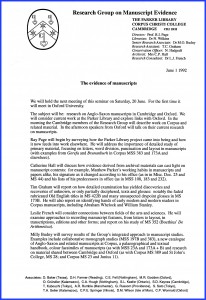
Invitation Page 1
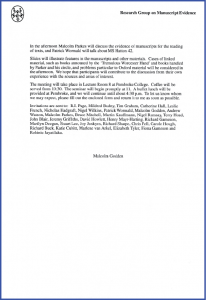
Invitation Page 2
In the Series of Seminars on the Evidence of Manuscripts
Mostly at the Parker Library, Corpus Christi College, Cambridge
20 June 1992
Invitation in pdf.
The previous Seminar in the series considered
“Corpus Christi College MSS 23 and 223: The Corpus Prudentius and the Saint-Bertin Prudentius”
Parker Library, 5 June 1992
For the first time, the Seminar met in Oxford University. And not for the only time. Two more such Seminars followed in Oxford, before the close of the Series. They took place March 1993 and in April 1994.
Photographic Exhibition Included
Each time, the Oxford meetings of the Series had a travelling exhibition of photographs from manuscripts and other materials, mostly from Corpus Christi College, Cambridge, home of the Research Group. This first Seminar at Oxford established the custom, which extended to the Research Group’s visit to Japan several months later, in November and December 1992, and to its activities at the International Congress on Medieval Studies in both 1993 and 1994, of bringing the manuscripts, at least in the form of photographic reproductions, to the people.
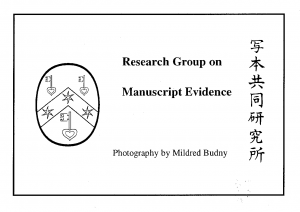 *****
*****
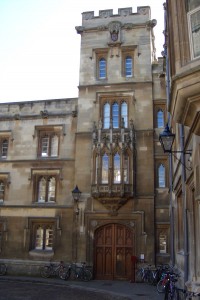
Entrance to Pembroke College in Pembroke Square. Photo by Jakob Leimgruber (JREL) via Wikipedia Commons.
Plan
With the subject of “research on Anglo-Saxon manuscripts in Cambridge and Oxford” — and with the characteristics of the venue as well as the willing assembly of interests and expertise — the Invitation Letter describes the aims and elements of the meeting.
We will consider current work at the Parker Library and explore links with Oxford. In the morning the Cambridge members of the Research Group will describe work on Corpus and related material. In the afternoon speakers from Oxford will talk on their current research on manuscripts.
Ray Page will begin by surveying how the Parker Library project came into being and how it now feeds into work elsewhere. He will address the importance of detailed study of primary material, focusing on letters, word division, punctuation and layout in manuscripts (with examples from Gerefa and Brunanburh in Corpus MSS 383 and MS 173A and elsewhere).
Catherine Hall will discuss how evidence derived from archival materials can cast light on manuscript contexts: for example, Matthew Parker’s working habits in manuscripts and papers alike, his signature as it changed according to his office (as in Misc. Doc. 25 and MS 44) and his lists of his predecessors in office (as in MSS 108, MS 183 and MS 232).
Tim Graham will report on how detailed examination has yielded discoveries and recoveries of unknown, or only partially deciphered, texts and glosses: notably the faded rubricated titles in MS 422B and many unsuspected drypoint glosses in MS 173B. He will also report on identifying hands of early modern and modern readers in Corpus manuscripts, including Abraham Whelock and William Stanley.
Leslie French will consider connections between fields of the arts and sciences. He will examine approaches to recording manuscript features, from letters to layout, in transcriptions, editions and other forms; and report on his study of MS 352 (Boethius’ De Arithmetica).
Milly Budny will survey results of the Group’s integrated approach to manuscript studies. Examples include collaborative monograph studies (MSS 197B and 383), a new catalogue of Anglo-Saxon and related manuscripts at Corpus, a palaeographical and textual handbook, colour facsimiles of manuscripts (as with MSS 23A and 173 A+B) and research on material shared between Cambridge and Oxford (as with Corpus MS 389 and St John’s College, MS 28; and Corpus MS 23 and Junius 11).
In the afternoon Malcolm Parkes will discuss the evidence of manuscripts for the reading of texts, and Patrick Wormald will talk about MS Hatton 42.
Images of Originals
The Letter points to the presence of photographic reproductions as part of the proceedings.
Slides will illustrate features in the manuscripts and other materials. Cases of linked material, such as books annotated by the ‘Tremulous Worcester Hand’ and books handled by Parker and his circle, and problems particular to Oxford material will be considered in the afternoon. We hope that participants will contribute to the discussion from their own experience with the sources and areas of interest.
Also, an exhibition of photographs mounted on foamboards travelled to Oxford for the purpose. The Research Group Archives for this Seminar retain the set of printouts used for the captions for the display boards and a set of snapshots of the layout of the display on this occasion.
 Place, Time, People, Lunch
Place, Time, People, Lunch
The meeting will take place in Lecture Room 8 at Pembroke College. Coffee will be served from 10:30. The seminar will begin promptly at 11. A buffet lunch will be provided at Pembroke, and we will continue until about 4:30 p.m. To let us know whom we may expect, please fill out the enclosed form and return it to me as soon as possible.
Invitations sent to:
R.I. Page, Mildred Budny, Tim Graham, Catherine Hall, Leslie French, Nicholas Hadgraft, Nigel Wilkins, Patrick Wormald, Malcolm Godden, Andrew Watson, Malcolm Parkes, Bruce Mitchell, Martin Kauffmann, Nigel Ramsay, Terry Hoad, John Blair, Jeremy Griffiths, David Howlet, Henry Mayr–Harting, Richard Gameson, Marilyn Deegan, Stuart Lee, Joy Jenkyns, Richard Sharpe, Chris Fell, Carole Hough, Richard Buck, Katie Cubitt, Marlene van Arkel, Elizabeth Tyler, Fiona Gameson and Rohinie Jayatilaka.
It was agreed that the experience of a Seminar in the Series was worth repeating at Oxford. The generous hospitality which Professor Godden, his wife Julia, and others extended to the whole travelling band of the Research Group for the visit and its overnight stay deserves long-term thanks.
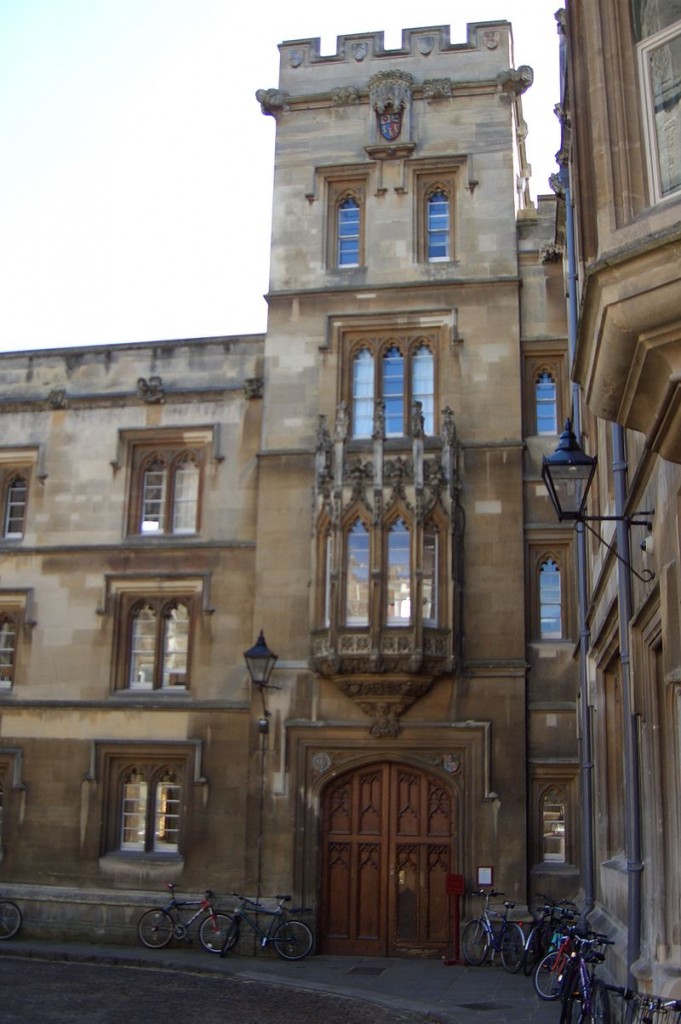
Entrance to Pembroke College. Photo by Jakob Leimgruber (JREL) via Wikipedia Commons.
*****
The next set of Seminars, Workshops, or Sessions in the Series took place in Japan. Similarly accompanied by photographic exhibitions, they considered:
- “The Research Group on Manuscript Evidence and Its Work”
November 1992
- “Aspects of the Research Group on Manuscript Evidence”
December 1992
- “The Integrated Approach to Manuscript Studies”
December 1992
The next Seminar in England considered:
Before long, the Seminar revisited Oxford:
*****
The design and layout, as well as some of the images, of the exhibition of photographs which the Research Group brought to this first Seminar in Oxford in mid-1992 served as the template for its exhibitions in Japan in November–December and then in the United States in both May 1993 and May 1994, respectively for the 27th and 28th International Congress on Medieval Studies. For the latter Congress, the exhibition accompanied the opening of a new center for Anglo-Saxon Manuscript Studies, modeled in part upon the work of the Research Group on Manuscript Evidence.
*****
Some Publications Arising
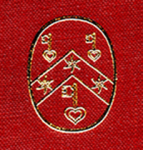 Besides the other publications which emanated from some presentations at this Seminar — for example, from within the Research Group on Manuscript Evidence, Timothy Graham‘s careful work on the drypoint glosses and the annotating habits of Wheelock and Stanley — some of the manuscripts considered and exhibited photographically figure in one or more of the Research Group publications or planned publications. From the beginning, we understood the importance of reproducing, insofar as possible, photographic reproductions (preferrably high-quality) of the material evidence of the manuscripts.
Besides the other publications which emanated from some presentations at this Seminar — for example, from within the Research Group on Manuscript Evidence, Timothy Graham‘s careful work on the drypoint glosses and the annotating habits of Wheelock and Stanley — some of the manuscripts considered and exhibited photographically figure in one or more of the Research Group publications or planned publications. From the beginning, we understood the importance of reproducing, insofar as possible, photographic reproductions (preferrably high-quality) of the material evidence of the manuscripts.
And so, much of our energies were dedicated to photographic work, guided by scholarly interests and expertise, and to the preparations to disseminate its results to the wider world of scholars, students, and others interested in the transmission of learning, language, history, literature, and many other elements of human experience across time and space. That other challenges, some practical, some not, interfered with the accomplishment of all those plans (published facsimiles included, despite the completion of the photographic work for them) may be partly due to the conditions of a dedicated and talented research project subjected to insufficient resources and contextual support, given the nature of the world at large in a crucial transitional period in the history of scholarship and research in the British Isles and elsewhere.
Those reflections may deserve another forum. Here, let us celebrate the collaborative activities between centers and fields of study, and the forms of publications which did emerge, in the welcome for the integrated approach to manuscript studies, Anglo-Saxon manuscripts included, in Cambridge and Oxford (and elsewhere), which the Series of Seminars on “The Evidence of Manuscript” was able to find, to enjoy, and to extend, even into other parts of the world.
“Matthew Parker in Cambridge” Exhibition & Booklet
Catherine Hall’s examination of scripts and documents relating to “Matthew Parker in Cambridge” turned into an exhibition at the Parker Library itself, as well as a Catalogue Booklet, with Mildred Budny’s photographs. The exhibition extended from October 1993 to February 1994. Its booklet was reprinted as an Appendix to an issue of the Old English Newsletter (Volume 27:1) for Fall 1993, and now it is available online with the digitization of the Old English Newsletter Archives. Its plates reproduce part of Misc. Doc. 25 (Catalogue Item 5) demonstrated in her presentation for the Seminar at Pembroke College.
The Palaeographical and Textual Handbook
and the Illustrated Catalogue

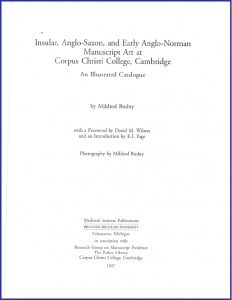 Besides the photographs painstakingly prepared for many of the Corpus manuscripts, and intended for analogue facsimiles (remember, this was before digital photography came to dominate as more-or-less viable, let alone admirable, methods of communicating images), some of them found places in the prototype of the Palaeographical and Textual Handbook (previewed in an early Seminar in the series). A larger group of them reached print at last in the 2-volume Illustrated Catalogue of Insular, Anglo-Saxon, and Early Anglo-Norman Manuscript Art at Corpus Christi College, Cambridge co-published by the Research Group on Manuscript Evidence (2 volumes, 1997).
Besides the photographs painstakingly prepared for many of the Corpus manuscripts, and intended for analogue facsimiles (remember, this was before digital photography came to dominate as more-or-less viable, let alone admirable, methods of communicating images), some of them found places in the prototype of the Palaeographical and Textual Handbook (previewed in an early Seminar in the series). A larger group of them reached print at last in the 2-volume Illustrated Catalogue of Insular, Anglo-Saxon, and Early Anglo-Norman Manuscript Art at Corpus Christi College, Cambridge co-published by the Research Group on Manuscript Evidence (2 volumes, 1997).
In both cases, the photographs are accompanied by, and intended to illustrate, it may be to confirm, detailed observation and analysis.
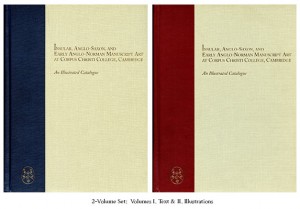 The Illustrated Catalogue (2 volumes, 1997) emanated from the long-term, integrated research work on selected Anglo-Saxon and related manuscripts at The Parker Library of Corpus Christi College, Cambridge. The stages of the research work are recorded, for example, in the Annual Reports to the Leverhulme Trust, described in our Publications. Many of the catalogue entries, as noted therein, report the results of discoveries and discussions emerging in our series of Seminars, including this one.
The Illustrated Catalogue (2 volumes, 1997) emanated from the long-term, integrated research work on selected Anglo-Saxon and related manuscripts at The Parker Library of Corpus Christi College, Cambridge. The stages of the research work are recorded, for example, in the Annual Reports to the Leverhulme Trust, described in our Publications. Many of the catalogue entries, as noted therein, report the results of discoveries and discussions emerging in our series of Seminars, including this one.
The manuscripts in the Catalogue which we examined, at a distance, in the first Oxford Seminar are:
- MS 23, Part I = Budny Number 24 (The Corpus Prudentius)
- MS 44 = Budny Number 46 (The Corpus Canterbury Pontifical)
- MS 144 = Budny Number 6 (The Corpus Glossary)
- MS 173, Part I [or A] = Budny Number 11 (Parker Chronicle and Laws)
- MS 173, Part II [or B] = Budny Number 4 (The Corpus Sedulius)
- MS MS 183 = Budny Number 12 (King Athelstan’s Presentation Copy of Bede’s Vita Sancti Cuthberti and Other Texts)
- MS 197, Part I [or B] = Budny Number 3 (The Cambridge Portion of the Cambridge–London Gospels)
- MS 352 = Budny Number 20 (Boethius’s De Instituione Arithemetica)
- MS 389 = Budny Number 23 (The Vitae of Saints Paul and Guthlac by Saint Jerome and Felix)
Also, specimens from all of these manuscripts were selected for the Palaeographical and Textual Handbook, along with MS 383.
*****

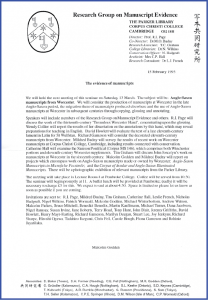
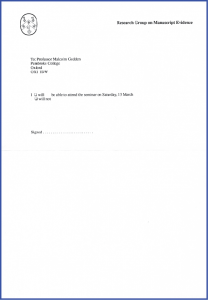









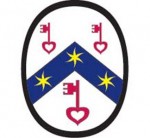
2003 Colloquium on “Innovations for Editing Texts”
January 1, 2014 in Conference Announcement, Events
Since 2001, the Research Group has jointly sponsored scholarly meetings, co-organized by Mildred Budny and held at various centers. These events constitute the New Series of Seminars, Workshops, Colloquia & Symposia.
The series began with
Problems and Potential of Dating Materials from the Early Medieval Period”
an Inaugural and Celebratory Workshop
held at The College of New Jersey (November 2001)
Form and Order in the Anglo-Saxon World, 400–1100”
a Colloquium
held at the British Museum (March 2002)
Then we focused on:
from Antiquity to Enlightenment”
A Colloquium
(The Ohio State University, Columbus, 2003)
Co-organized by Mildred Budny and Frank T. Coulson
Co-sponsored by
The Colloquium (sometimes also called a Workshop) was held at the Center for Epigraphical and Palaeographical Studies in October 2003.
This multidisciplinary meeting examined the merits of innovations, from the Classical period onward, for editing materials of many kinds, ranging from texts and glosses, through music, drama, and rituals, to inscriptions and illustrations. The assembled experts explored problems, methods, and potential solutions for a variety of languages and types of texts, including literary as well as “unauthored” works, commentaries, and texts with single or multiple witnesses. Among the areas of concern were the extent to which Classical techniques of editing are valid for forms of evidence from the medieval and later periods.
Speakers and Moderators
Introduction and Welcome
Session 1. Historical Texts
Moderator: Barbara A. Hanawalt (Department of History and Center for Medieval and Renaissance Studies,
The Ohio State University)
“Making Frechulf’s Histories“
“Authorial Revisions, Fluid Texts, and Contamination:
The Cases of Eriugena and William of Conches”
” ‘Man is an Animal; Man is Not an Animal’:
How John Scottus Eriugena Edited out Art”
Session 2. Computers, Digitization, and Editing
Moderator: Robert Stevick (University of Washington, Seattle)
“Sweeping the Cutting-Room Floor:
Ordered Visualization of Editorial Scraps in the Electronic Edition”
“Will the Real Edition Please Stand Out?
Negotiating Multiple Textual Representations in Digital Editions”
Longwood University, Farmville, Virginia)
“Options for Future Access:
Web Publishing and Digitizing Old French Texts”
Session 3. Latin Texts
Moderator: Ralph Hexter (Department of Classics, University of California at Berkeley)
” ‘Untrammeled Eclecticism’: Towards a New Text of Sedulius”
“The Catalogus translationum et commentariorum and the Editing of Medieval and Renaissance Commentaries”
“Problems and Challenges in the Editing of Medieval and Renaissance Commentaries”
Gil Renberg (Department of Greek and Latin, The Ohio State University)
“The Unique Text of the Passio S. Perpetuae in Monte Cassino 204 and the Group of Campanian Texts Descended from Late-Antique North African Exemplars”
Session 4. Commentaries, Glossaries, and Glosses
Moderator: Anna A. Grotans (Department of Germanic Languages and Literatures, The Ohio State University)
“Pieces on a Page:
Historical Models and Contemporary Methods of Arranging Commentary and Text”
“Editing Unauthored and Scribal Texts: Problems with Glossaries”
“Issues in Editing Syntactical Glosses”
“Cloning or Transplantation?
Options for Editing 12th-Century Commentaries on the Ars mediocinae (Articella)”
Session 5. English Vernacular Texts
Moderator: Christopher A. Jones (Department of English, The Ohio State University)
“Innovative Scribes and Unstable Texts: The Challenges of Editing Middle English Texts”
“Metrical Emendation in the Anglo-Saxon Poetic Records”
“Drama Manuscripts as Self-Performing Artifacts”
Session 6. Music, Liturgy, and the Visual Arts
Moderator: Carol Neuman de Vegvar (Department of Fine Arts, Ohio Wesleyan University, Delaware, Ohio)
“The Edition of the Gregorian Gradual”
“Editor or Audience? Problems with a Marian Officium“
“Medieval Scribal and Pictorial Editing in the Marvels of the East“
Mildred Budny (Research Group on Manuscript Evidence, Princeton)
“The Once and Future CORPUS Project”
[Note: Thomas H. Ohlgren was unable to attend, so Mildred Budny presented their joint paper.]
Session 7. Anglo-Saxon Manuscripts and Sources
Moderator: Mildred Budny
“Editing and Unediting the Exeter Book: A Textual Analysis”
“Spaced-out Beowulf and Aerated Alexander: A Needlessly Occult Aspect of Editing”
“The Author, the Text, and the Compiler: What’s an Editor to Do When New is Old?”
Concluding Remarks
*****
Photography by Raymond Cormier
*****
Laid out in Adobe Garamond™ by Leslie French, the Poster, Booking Form, and Program for the Colloquium are available here in pdf:
*****
CORPUS ‘Project Abstract’ (2003), Page 1
Release 1.0 (1994)
The presentation at the Colloquium reporting the CORPUS of Insular, Anglo-Saxon, and Early Anglo-Norman Manuscript Art represents part of the long-term commitment by the Research Group to this collaborative reference tool which catalogues, indexes, and illustrates the surviving manuscript art of the British Isles for the period 650–1100 CE. In book form, it appeared as Insular and Anglo-Saxon Illuminated Manuscripts: An Iconographic Catalogue, C. A.D. 625 to 1100, compiled and edited by Thomas H. Ohlgren (1986), with contributions by many scholars. By the time of the Colloquium, the project — with Mildred Budny’s permission at Tom Ohlgren’s request — had by 1996 changed its name, inspired by the title of her then-still-forthcoming Illustrated Catalogue (1997). The CORPUS Project Abstract, prepared by Thomas Ohgren and Mildred Budny in late 2002, was circulated as a handout at the Colloqium, and now can be downloaded here.
Thomas Ohlgren’s ‘Iconographic Catalogue’ (1986)
Title Page (1986)
A Report of the “Contributions by the Research Group on Manuscript Evidence” to the project in earlier years was presented by Mildred Budny at the 1993 Congress and published in the Old English Newsletter, Volume 23, Number 3 (1993), A-8 – A-23, now online. By the next year, the revised and expanded HyperText version (Release 1.0) of CORPUS had appeared (1994), followed by further updates behind the scenes over the succeeding years leading to the Project Abstract as presented at the Ohio State Colloquium.
*****
This Colloquium/Workshop expanded the subject of one of the Sessions sponsored by the Research Group at the 2003 Congress in May.
After this Colloquium, for the next few years, the Research Group concentrated on
The resumption of Symposia and similar Events began with
More of them followed in time. See the New Series.
*****
Tags: Anglo-Saxon Poetic Records, Ars medicinae, Beowulf, Catalogus translationum et commentariorum, Center for Epigraphical and Palaeographical Studies, CORPUS Project, Digital Editions, Editing Glossaries, Editing Middle English Texts, Electronic Editions, Exeter Book of Old English Poetry, Frechulf's Histories, Gregorian Gradual, History of Editing, Index of Christian Art, Index of Christian Art at Princeton University, John Scottus Eruigena, Letter of Alexander to Aristotle in Beowulf Manuscript, liturgico-canonical texts, Marian Officinum, Marvels of the East, Medieval Drama Manuscripts, Metrical Emendation, Monte Cassino MS 204, Old English Newsletter, Old French Texts, Passio Sanctae Perpetuae, Sedulius, Syntactical Glosses, The Center for Epigraphical and Palaeographical Studies, The Ohio State University, William of Conches
No Comments »